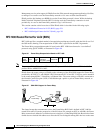
Overview of IBM Networking
SNA FRAS
BC-223
Cisco IOS Bridging and IBM Networking Configuration Guide
78-11737-02
Table 3 shows how the QLLC commands correspond to the SDLLC commands.
Other Implementation Considerations
Consider the following when implementing QLLC conversion:
• To use the QLLC conversion feature, a router must have a physical link to an X.25 public data
network (PDN). It must also have an SRB/RSRB path to an IBM FEP. This link could be a Token
Ring or Ethernet interface, or even FDDI, if RSRB is being used.
• QLLC conversion can run on any router with at least one serial interface configured for X.25
communication and at least one other interface configured for SRB or RSRB.
• QLLC conversion security depends upon access control in SRB/RSRB and X.25 and upon XID
validation.
You can configure DLSw+ for QLLC connectivity, which enables the following scenarios:
• Remote LAN-attached devices (physical units) or SDLC-attached devices can access an FEP or an
AS/400 over an X.25 network.
• Remote X.25-attached SNA devices can access an FEP or an AS/400 over a Token Ring or over
SDLC.
For information on configuring DLSw+ for QLLC conversion, refer to the “Configuring DLSw+”
chapter.
You can configure DSPUs for QLLC. For more information on this configuration, refer to the
“Configuring DSPU and SNA Service Point” chapter.
SNA FRAS
Using Frame Relay Access Support (FRAS), the Cisco IOS software allows branch SNA devices to
connect directly to a central site front-end processor over a Frame Relay network. FRAS converts LAN
or Synchronous Data-Link Control (SDLC) protocols to a Frame Relay format understood by the
Network Control Program (NCP) that runs in an FEP. The Cisco IOS software and the NCP support two
frame formats:
• RFC 1490 routed format for LLC2, specified in the FRF.3 Agreement from the Frame Relay Forum
and known in NCP literature as Frame Relay Boundary Network Node (BNN) support. Support for
this feature requires NCP 7.1 or higher.
• RFC 1490 802.5 source-route bridged format, known in NCP literature as Frame Relay Boundary
Access Node (BAN) support. Support for this feature requires NCP 7.3 or higher.
Table 3 QLLC and SDLLC Command Comparison
QLLC Command Analogous SDLLC Command
qllc largest-packet sdllc ring-largest-frame, sdllc
sdlc-largest-frame
qllc partner sdllc partner
qllc sap sdllc sap
qllc srb, x25 map qllc, x25 pvc qllc sdllc traddr
qllc xid sdllc xid
source-bridge qllc-local-ack source-bridge sdllc-local-ack


















